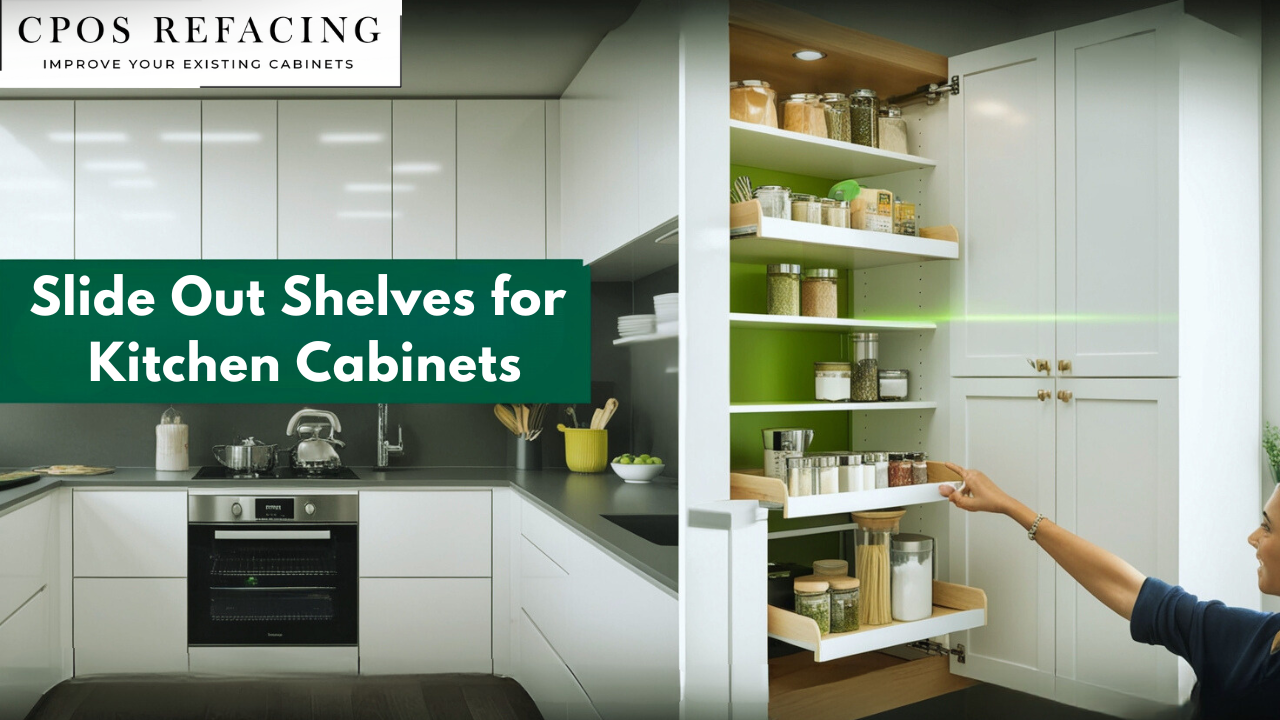Business
Organize Easily with Slide Out Shelves for Kitchen Cabinets

Are you tired of digging through cluttered kitchen cabinets? Searching for that elusive spice or pot? If so, it might be time to consider an upgrade. Slide out shelves for kitchen cabinets can transform your cooking space from chaotic to organized in no time. These clever additions not only make accessing your items a breeze but also maximize the often-overlooked storage potential of your cupboards. Imagine effortlessly gliding out full racks of spices, canned goods, and cookware at the pull of a handle. Say goodbye to backaches and frustrations let’s explore how slide out shelves can revolutionize your kitchen experience.
Why Choose Slide Out Shelves for Kitchen Cabinets?
Slide out shelves for kitchen cabinets transform the way you access your items. No more digging through dark corners or awkwardly reaching for that elusive spice jar. With a simple pull, everything is within arm’s reach.
These shelves maximize space efficiency. They utilize every inch of your cabinet while ensuring that nothing gets lost in the back. This organization method keeps your kitchen neat. Durability is another key benefit. High-quality slide out shelves can withstand heavy loads without warping or breaking down over time. Investing in these systems means fewer replacements and repairs.
The aesthetic appeal adds to their allure as well. These sleek designs complement any kitchen decor, enhancing both functionality and style simultaneously. Choosing to slide out shelves means prioritizing convenience and organization an essential upgrade for any busy home chef.
Types of Slide Out Shelves for Kitchen Cabinets
When exploring slide out shelves for kitchen cabinets, you’ll find a variety of options designed to enhance your storage space. Wooden slide out shelves offer a classic look and sturdy construction. They seamlessly blend with traditional cabinetry while providing reliable durability.
Metal slide out shelves are perfect for modern kitchens. Their sleek design and robust materials can handle heavier items, making them ideal for pots and pans. Wire baskets are another popular choice. They allow for ventilation, reducing moisture buildup on produce or pantry items. These open designs make it easy to see what you have at a glance.
Adjustable shelving units provide flexibility to cater to changing storage needs. You can customize the height between each shelf based on what you’re storing. Each type has its unique features tailored to different preferences and requirements in organizing kitchen spaces effectively.
How to Install Slide Out Shelves for Kitchen Cabinets
Installing slide out shelves for kitchen cabinets is a straightforward process that can make a big difference in your space. Start by measuring the cabinet’s interior to ensure the shelves fit perfectly.
Next, gather your tools: a drill, screws, and a level are essential. Mark where you want to place the shelf brackets on both sides of the cabinet. Use a level to keep everything straight.
Drill pilot holes carefully to avoid splitting the wood. Attach the brackets securely using screws, ensuring they’re aligned with each other for smooth operation. Once all brackets are installed, simply slide in your new shelves and test their movement. Adjust as needed until they glide effortlessly in and out of the cabinet.
This simple installation method transforms your kitchen organization without requiring advanced skills or complicated steps.
Choosing the Right Slide Out Shelves for Your Needs
Choosing the right slide out shelves for kitchen cabinets involves considering both your space and storage needs. Start by measuring your cabinet dimensions. Accurate measurements ensure a perfect fit.
Next, think about what you plan to store. For heavier items like pots and pans, look for sturdy materials such as plywood or metal. Lighter options work well for spices or dishes. Consider the style of your kitchen too. Choose finishes that complement your cabinetry this adds aesthetic appeal while improving functionality.
Don’t overlook installation ease either; some shelves come with pre-drilled holes which simplify setup significantly.
Read reviews and ask friends for recommendations on brands they trust. The right choice can transform how you organize and access items in your kitchen effortlessly.
Benefits of Slide Out Shelves for Kitchen Cabinets
Slide out shelves for kitchen cabinets transform the way you organize your space. They provide easy access to items stored in hard-to-reach areas, allowing you to maximize every inch of your cabinetry. With these shelves, clutter becomes a thing of the past. You can arrange pots, pans, and pantry items neatly without the hassle of digging through stacks. This not only saves time but also reduces frustration during meal prep.
Durability is another key advantage. Most slide out shelves are crafted from sturdy materials that withstand daily use while maintaining their functionality over time.
Moreover, they enhance safety by minimizing the risk of accidents. No more balancing on tiptoes or stretching awkwardly to retrieve something from the back everything is within arm’s reach. Slide out shelves add aesthetic value to your kitchen design. A streamlined look elevates overall decor and makes your cooking area feel inviting and organized.
Customizing Slide Out Shelves for Your Kitchen
Customizing slide out shelves for your kitchen can elevate both functionality and style. You have the freedom to choose materials that complement your cabinetry, whether it’s solid wood, laminate, or metal.
Think about the depth and width of each shelf. Tailoring these dimensions ensures you maximize available space while accommodating various items like pots, pans, or pantry goods. Consider adding dividers or compartments for better organization. This feature helps manage different sizes of containers and keeps everything easily accessible.
Don’t forget about aesthetics. Adding a finish that matches your kitchen decor can create a seamless look. Decorative hardware also adds a personal touch while improving usability.
Lighting is another aspect to consider. Installing LED strips underneath the shelves can illuminate dark corners and make accessing ingredients simpler during cooking sessions. Personalization adds value to function in any space!
Cost and Budget Considerations
When considering slide out shelves for kitchen cabinets, cost is a key factor. Prices can vary significantly based on materials and design. For instance, basic wooden or laminate options are generally more affordable than high-end metal or custom designs.
Installation also plays a role in the overall budget. If you choose to hire a professional, labor costs can add up quickly. However, many systems are designed for easy DIY installation if you’re handy with tools.
Think about long-term value as well. While investing more initially might seem daunting, durable shelves can save you money down the line by reducing wear and tear on your cabinets.
It’s wise to compare different brands and models online before making a decision. Look for sales or discounts that might be available, especially during seasonal promotions. This will help stretch your budget further while upgrading your kitchen organization.
Tips for Maintaining Slide Out Shelves
Regular cleaning is essential for maintaining slide out shelves. Wipe them down with a damp cloth and mild detergent to remove dust and spills. Avoid abrasive cleaners that could scratch the surface.
Check the sliding mechanisms periodically. Ensure they are free of debris and lubricate them if necessary. A little silicone spray can go a long way in keeping things running smoothly. Be mindful of weight limits when loading your shelves. Overloading can cause wear on the slides, leading to potential damage over time.
Adjustments may be needed as wood or materials settle. Keep an eye on alignment it’s easy to fix minor issues before they become major problems. Organize items wisely store frequently used items at eye level for easy access, which helps reduce strain on both you and your shelves.
Organize Your Kitchen with Ease
Organizing your kitchen can feel like a daunting task, but with slide-out shelves for kitchen cabinets, it becomes a manageable and efficient process. These innovative storage solutions maximize your space and enhance accessibility to all your items. By opting for slide-out shelves, you’re investing in convenience and functionality.
Whether you’re looking to declutter or simply want easier access to pots and pans, these shelves are an ideal choice. There’s something for everyone from various types available to simple installation methods. Additionally, customizing them ensures that they meet your precise needs while complementing the design of your kitchen.
Cost considerations may vary depending on materials and sizes, yet the long-term benefits far outweigh initial expenses. Regular maintenance will keep them functioning smoothly for years ahead.
Business
San Diego Immigration Lawyer Your Guide to US Immigration Laws

Introduction
The United States immigration system is complex and ever-evolving, making it challenging for individuals and families seeking legal residency, work authorization, or citizenship. Navigating this intricate legal framework requires expert guidance,online texas divorce which is where an experienced San Diego immigration lawyer can be invaluable. Whether you are applying for a visa, facing deportation, or seeking asylum, understanding the basics of US immigration laws is essential to securing your future in the country.
Understanding US Immigration Laws
US immigration laws govern the entry, stay, and naturalization of foreign nationals. The laws are primarily enforced by the U.S. Citizenship and Immigration Services (USCIS), Immigration and Customs Enforcement (ICE), and the Department of Homeland Security (DHS). Immigration policies cover various categories, including family-based immigration, employment-based immigration, humanitarian relief, and non-immigrant visas.
1. Family-Based Immigration
One of the most common ways to obtain a green card (lawful permanent residency) in the United States is through family sponsorship. U.S. citizens and lawful permanent residents (LPRs) can petition for certain family members to immigrate. There are two main categories:
- Immediate Relatives: Spouses, children (under 21), and parents of U.S. citizens.
- Family Preference Categories: Siblings, married children, and extended family members, subject to numerical caps and long waiting periods.
2. Employment-Based Immigration
The U.S. offers various employment-based visas for skilled workers, investors, and professionals in high-demand fields. These include:
- H-1B Visa: For skilled workers in specialized occupations.
- L-1 Visa: For intra-company transferees.
- O-1 Visa: For individuals with extraordinary abilities.
- EB-5 Visa: For investors who create jobs in the U.S.
A San Diego immigration lawyer can assist with work visa applications, employer sponsorships, and labor certification processes.
3. Humanitarian Immigration Options
Individuals facing persecution, violence, or humanitarian crises may qualify for relief through:
- Asylum: Protection for individuals fleeing persecution due to race, religion, nationality, or political beliefs.
- Temporary Protected Status (TPS): Given to individuals from countries experiencing conflict or disaster.
- U Visa & VAWA (Violence Against Women Act): For victims of crimes and domestic violence.
4. Non-Immigrant Visas
These visas allow foreign nationals to stay in the U.S. temporarily for various purposes, including tourism (B-2), business (B-1), education (F-1), and exchange programs (J-1). A skilled immigration attorney can help determine the right visa type and ensure compliance with legal requirements.
The Role of a San Diego Immigration Lawyer
An immigration lawyer provides essential legal services to individuals navigating the U.S. immigration system. Their roles include:
- Visa Applications & Green Card Processing: Ensuring proper documentation and adherence to legal requirements.
- Deportation Defense: Representing clients in removal proceedings.
- Citizenship & Naturalization: Guiding eligible immigrants through the naturalization process.
- Appeals & Waivers: Challenging denied applications and seeking waivers for inadmissibility issues.
Why Hire a San Diego Immigration Lawyer?
- Expert Knowledge: Immigration attorneys stay updated on changing laws and policies, ensuring accurate advice.
- Avoid Costly Mistakes: Errors in applications can lead to delays or denials.
- Personalized Assistance: Every immigration case is unique, requiring tailored legal strategies.
- Legal Representation: In case of immigration court proceedings, legal representation is crucial.
Finding the Right Immigration Lawyer in San Diego
When selecting an immigration lawyer, consider factors such as:
- Experience and specialization in immigration law.
- Positive client testimonials and case success rates.
- Transparent fee structures.
- Effective communication and responsiveness.
Conclusion
Navigating the U.S. immigration system can be overwhelming, but with the help of a qualified San Diego immigration lawyer, you can increase your chances of a successful outcome. Whether you need assistance with visas, green cards, asylum applications, or deportation defense, professional legal support is invaluable in securing your American dream.
Business
Exclusive Custom Homes in Bloomfield Hills, Michigan

Bloomfield Hills, Michigan, is synonymous with luxury living, offering a combination of natural beauty, upscale communities, and architectural excellence. For those seeking a home that is as unique as their lifestyle, exclusive custom homes in Bloomfield Hills present the perfect opportunity. These homes are crafted with meticulous attention to detail, high-end materials, and personalized design to create residences that stand apart from traditional builds. With a focus on elegance, functionality, and innovation, custom home builders in Bloomfield Hills bring dream homes to life.
Why Bloomfield Hills Is the Ideal Location for Custom Homes
Bloomfield Hills is one of Michigan’s most desirable locations for luxury homes, known for its serene neighborhoods, excellent schools, and close proximity to cultural and recreational attractions. The area’s charm lies in its mix of beautiful natural landscapes and sophisticated amenities. Residents enjoy a peaceful suburban environment with easy access to nearby cities like Birmingham and Detroit. This combination makes Bloomfield Hills a prime destination for building exclusive custom homes that offer privacy, comfort, and convenience.
Personalized Design Tailored to Every Lifestyle
Exclusive Best custom home builders bloomfield hills michigan Hills are designed to reflect the unique preferences and lifestyles of their owners. Unlike pre-built homes, custom homes offer limitless possibilities for personalization. Homeowners work closely with architects and builders to design spaces that match their exact needs and aesthetic preferences. Whether it’s a grand foyer, a state-of-the-art home theater, or a custom wine cellar, every detail is carefully considered to create a home that is both functional and luxurious.
Architectural Excellence and Unique Features
Custom homes in Bloomfield Hills stand out for their architectural diversity and distinctive features. From classic Georgian and Tudor styles to sleek contemporary designs, the area’s custom homes blend traditional charm with modern innovation. Builders incorporate unique architectural elements such as vaulted ceilings, custom millwork, and expansive glass walls that showcase stunning views. These homes are built to impress, with every room designed to create a lasting impact while maintaining comfort and practicality.
High-Quality Materials and Finishes
The use of premium materials and finishes is a hallmark of exclusive custom homes in Bloomfield Hills. Builders source the finest materials to ensure both beauty and durability. From natural stone facades and custom hardwood flooring to designer lighting and handcrafted cabinetry, every detail speaks of luxury. Homeowners can choose from a wide range of high-end finishes to personalize their space, ensuring that every room reflects their individual taste and style.
Modern Amenities for Ultimate Comfort
Today’s custom homes are designed with modern living in mind, incorporating cutting-edge technology and luxury amenities. Smart home systems allow homeowners to control lighting, climate, security, and entertainment with ease. Many exclusive custom homes also feature spa-like bathrooms, chef’s kitchens with professional-grade appliances, and expansive outdoor living areas. Home gyms, home offices, and dedicated entertainment spaces are increasingly popular, making the home a true haven for work, relaxation, and recreation.
Outdoor Living Spaces and Natural Beauty
Bloomfield Hills is known for its picturesque surroundings, and custom home builders take full advantage of this natural beauty by designing stunning outdoor living spaces. From covered patios and outdoor kitchens to custom pools and landscaped gardens, these spaces are perfect for entertaining or enjoying quiet moments with family. Large windows and open floor plans create a seamless connection between indoor and outdoor spaces, allowing homeowners to fully appreciate the beauty of their surroundings.
Energy Efficiency and Sustainable Building Practices
Sustainability is becoming a key focus in custom home construction, and many builders in Bloomfield Hills are adopting eco-friendly practices. Energy-efficient windows, advanced insulation, and solar panel systems help reduce energy consumption while maintaining comfort. Geothermal heating and cooling systems, water-saving fixtures, and sustainable building materials further enhance the home’s efficiency and reduce its environmental impact. These features not only contribute to a greener lifestyle but also result in significant long-term savings for homeowners.
Collaboration and Transparency in the Building Process
Building an exclusive custom home is a highly collaborative process. Trusted builders in Bloomfield Hills prioritize open communication and transparency throughout the project. Homeowners are involved in every step, from the initial design phase to selecting finishes and monitoring construction progress. Regular updates and site visits ensure that the project stays on track, and any adjustments can be made promptly. This partnership ensures that the finished home meets or exceeds the client’s expectations.
A Long-Term Investment in Luxury and Comfort
An exclusive custom home in Bloomfield Hills is more than just a residence—it’s an investment in a lifestyle of luxury and comfort. These homes are built to stand the test of time, combining timeless design with modern amenities. The use of high-quality materials and superior craftsmanship ensures that the home retains its beauty and functionality for years to come. Homeowners not only enjoy a personalized living experience but also benefit from increased property value and long-lasting satisfaction.
Conclusion
Exclusive custom homes in Bloomfield Hills offer the perfect combination of luxury, personalization, and architectural excellence. With a focus on modern amenities, high-quality materials, and innovative design, these homes cater to the most discerning homeowners. Whether you’re envisioning a sprawling estate or a contemporary masterpiece, Bloomfield Hills’ custom home builders have the expertise to bring your dream to life. Building a custom home in this prestigious community ensures a living experience that is truly unique and tailored to your lifestyle.
Business
DO YOU NEED A CASH LOAN FAST?

Life is unpredictable, and financial emergencies can arise when you least expect them. Whether it’s an unexpected medical bill, urgent car repairs, or just making ends meet until your next paycheck, sometimes you need quick access to cash. If you find yourself in such a situation, a fast cash loan might be the solution. In this article, we’ll explore quick loans what cash loans are, how they work, their benefits, potential risks, and alternative options to consider before taking one.
What Is a Cash Loan?
A cash loan is a type of short-term financing that allows borrowers to access funds quickly, usually within a few hours or days. These loans are typically unsecured, meaning you don’t need to provide collateral such as a car or home to get approved. They are designed to provide immediate financial relief for urgent expenses.
Common types of fast cash loans include:
- Payday Loans: Short-term loans that must be repaid by your next paycheck.
- Personal Loans: Unsecured loans that can be used for various expenses, usually repaid in fixed installments.
- Title Loans: Loans that use your vehicle as collateral.
- Credit Card Cash Advances: Withdraw cash from your credit card, though often with high fees.
- Online or Peer-to-Peer Loans: Loans obtained through online lenders or lending platforms.
How Do Cash Loans Work?
The process of getting a cash loan is straightforward and usually involves the following steps:
- Application: Most lenders offer online applications that can be completed in minutes. You’ll need to provide basic personal and financial details.
- Approval: Depending on the lender, approval can take anywhere from a few minutes to a few hours.
- Funding: Once approved, the funds are typically deposited into your bank account within 24 hours or even the same day.
- Repayment: Repayment terms vary by loan type. Payday loans are usually due on your next payday, while personal loans have installment plans.
Benefits of Getting a Fast Cash Loan
- Quick Access to Funds
One of the biggest advantages of cash loans is their speed. Traditional loans from banks can take days or even weeks for approval, whereas cash loans provide almost instant relief.
- Simple Application Process
Many lenders require minimal documentation, and applications can often be completed online from the comfort of your home.
- No Collateral Required
Most cash loans are unsecured, meaning you don’t need to risk losing your assets.
- Flexible Loan Amounts
Depending on the lender, you can borrow small or large amounts, tailored to your needs.
- Bad Credit? No Problem
Some lenders offer cash loans to people with poor credit, making them accessible even if you have financial difficulties.
Potential Risks of Fast Cash Loans
While fast cash loans offer convenience, they also come with risks that you should consider:
- High Interest Rates and Fees
Many short-term loans, especially payday loans, come with extremely high-interest rates. If not repaid on time, you can end up paying much more than you borrowed.
- Debt Cycle Risk
Because of short repayment periods, many borrowers take out additional loans to cover existing ones, leading to a cycle of debt.
- Hidden Charges
Some lenders include processing fees, late payment fees, and rollover charges that can significantly increase the cost of borrowing.
- Impact on Credit Score
If you fail to repay the loan on time, it can negatively impact your credit score, making it harder to obtain loans in the future.
Alternatives to Cash Loans
Before committing to a fast cash loan, consider these alternative options:
- Borrow from Friends or Family
If you have a good relationship with family or friends, they may be willing to lend you money interest-free or at a low rate.
- Use a Credit Card
While cash advances come with fees, they may be more affordable than payday loans.
- Sell Unused Items
Selling unused electronics, furniture, or jewelry can be a quick way to get the money you need.
- Ask Your Employer for an Advance
Some employers offer paycheck advances, allowing you to access your wages early without the burden of high interest rates.
- Consider a Personal Loan from a Bank or Credit Union
Even if it takes a bit longer, traditional personal loans usually have lower interest rates compared to payday or title loans.
Tips for Choosing a Reputable Lender
If you decide a cash loan is your best option, follow these tips to ensure you’re working with a trustworthy lender:
- Check Reviews: Look for customer reviews and ratings online to gauge the lender’s reputation.
- Compare Interest Rates: Shop around to find the lowest rates and most favorable terms.
- Read the Fine Print: Make sure you understand all fees and repayment terms before signing.
- Avoid Predatory Lenders: Be cautious of lenders who don’t check your ability to repay or who push you into multiple loans.
Final Thoughts
Needing a cash loan fast can be stressful, but understanding your options can help you make the best decision. While cash loans provide quick financial relief, they should be used responsibly to avoid high costs and potential debt traps. Always explore alternative options and choose reputable lenders to ensure you’re making the right choice for your financial well-being.
If you’re considering a cash loan, take the time to assess your financial situation, compare lenders, and understand the terms before proceeding. Responsible borrowing can help you get through financial emergencies without long-term consequences.
-

 Health10 months ago
Health10 months agoDiscover ://vital-mag.net Blog: Expert Tips for Total Wellness
-

 Business11 months ago
Business11 months agoTikTok Affiliate Marketing | A Complete Guide for Marketers and Creators |
-

 Home and Gardening11 months ago
Home and Gardening11 months agoSunset Gardens Apartments: Complete Guide
-

 Health11 months ago
Health11 months ago7 Day Juice Fast Weight Loss Results: Expectations & Strategies
-

 Life style11 months ago
Life style11 months agoWhy i stopped eyelash extensions?
-

 Business11 months ago
Business11 months agoSecret Strategies of Competent Trading Companies
-

 Business11 months ago
Business11 months agoExploring the Social Media App Banality of Life
-

 entertainment11 months ago
entertainment11 months agoSWGoH Webstore: Improving Player Experience
